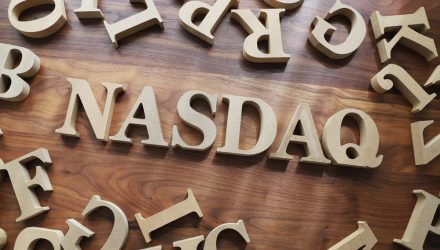For good reason, the Nasdaq-100 Index (NDX) is one of the hottest equity benchmarks this year and has been for some time. However, investors looking to reduce some of the risk associated with cap-weighted strategies while maintaining exposure to the NDX have options.
Consider the Direxion NASDAQ-100 Equal Weighted Index Shares (NYSEArca: QQQE) and the First Trust NASDAQ-100 Equal Weighted Index Fund (NasdaqGS: QQEW). QQQE and QQEW follow the Nasdaq-100 Index Equal Weight Index (NXDE).
Technology remains a favorite among investors, despite data suggesting technology stocks are relatively expensive as they trade at elevated price-to-earnings compared to the broader S&P 500. Equal-weight ETFs look to diminish unforeseen risks of traditional market cap-weighted funds by allocating to under-performing names upon rebalancing while reducing exposure to high fliers that could be ready to pullback.
“If an investor is looking to diversify within the universe of the Nasdaq-100, she can consider allocating to NDXE, the equal-weighted version of the NDX,” according to Nasdaq Global Indexes. “While not proven to be always superior from a return or risk perspective, NDXE offers investors the benefit of maintaining stable, 1%-each weightings to all 100 of NDX’s companies, rebalanced quarterly (as opposed to NDX’s annual rebalancing schedule).”
Lower Risk, Still Some Perks
Much of the advantage of afforded by equal-weight ETFs over time is attributed to either higher weights to small-caps or a tilt toward value names. With QQQE and QQEW, it’s likely more a symptom of the former rather than increased value exposure because the Nasdaq-100, regardless of cap-weighted or equal-weight posture, is primarily a growth index.
Due to the significant presence of large-caps throughout the tech sector, it is not a stretch to say the advantage of equal-weight strategies in the tech sector, such as those espoused by QQQE and QQEW, come by way increased to smaller and mid-cap equities.
Equal weighting “means that there is less of an implicit bet on mega-cap firms in general. Instead of a weighted-average market cap of $755bn, NDXE’s average market cap of $128bn reflects an 83% reduction in the index’s typical constituent size,” according to Nasdaq Global Indexes. “Practically speaking, it means that if Microsoft, Amazon, or Apple (currently weighted more than 10% each in NDX) were to experience a particularly bad day or month or year (down 20%, for example), the impact of a loss is muted by more than 90%, reducing total portfolio drag.”
For more on innovative portfolio ideas, visit our Nasdaq Portfolio Solutions Channel.
The opinions and forecasts expressed herein are solely those of Tom Lydon, and may not actually come to pass. Information on this site should not be used or construed as an offer to sell, a solicitation of an offer to buy, or a recommendation for any product.

